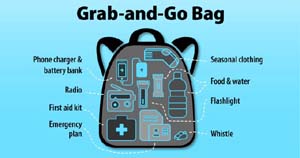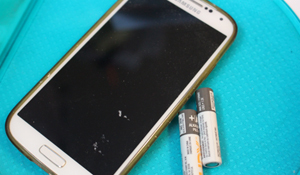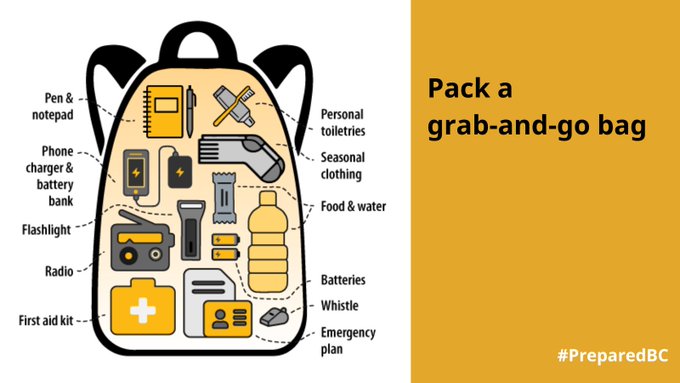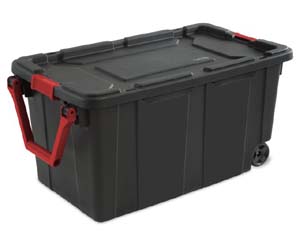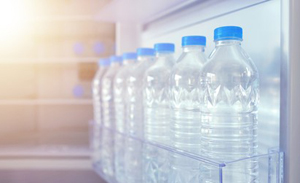Friday September 30, 2022 | SOOKE, BC
by Mary P Brooke | Island Social Trends
Anytime is a good time to review and update your at-home emergency preparedness.
An emergency kit is intended to provide most if not all of what you’ll need if you’re in an emergency situation such as power outage, flood or earthquake. Prepare the contents for at least 72 hours, or even a full week. You’ll include things for heating and cooking, hygiene and communication.
A grab-and-go bag is something you have ready for each person (and pet) in the household. You’ll want to include personal medications, special food items, batteries, wind-up radio, candles and matches. Tuck in an extra copy of medical prescriptions and the contact information of neighbours, friends and relatives; you might want to get those laminated or tuck them into a plastic bag.
Make sure your vehicle has enough gasoline or battery-charge to support you during an unexpected emergency.
Keep bottled water on hand. Have enough non-perishable food products in your home and kits (remember to freshen the supply every six months or so).
Preparation on Vancouver Island:
For years, people on Vancouver Island have been encouraged to develop grab-and-go bags. Have one for each member of the household. Keep them in a location you’re likely able to reach. Also have a kit in your car, and at your workplace.
“The grab-and-go bag is for when you have to flee or evacuate. The emergency kit is for hunkering down,” explains Jeri Grant, Juan de Fuca Emergency Program Coordinator.
Grab-and-go bags should be near the door or exit that you would use in the event of an emergency.
An emergency kit would include more items and might need a larger storage space like a shed.
Especially being on an island, there could be supply chain disruptions and communications could be down.
Contents for your kits and grab-bags:
Here is the BC Emergency Preparedness info for building a grab-and-go bag and an emergency kit.
Contents of a grab-and-go bag:
- Food (ready to eat) and water
- Phone charger and battery bank
- Small battery-powered or hand-crank radio
- Battery-powered or hand-crank flashlight
- Extra batteries
- Small first-aid kit and personal medications
- Personal toiletries and items, such as an extra pair of glasses or contact lenses
- Copy of your emergency plan
- Copies of important documents, such as insurance papers and identification
- Cash in small bills
- Local map with your family meeting place identified
- Seasonal clothing and an emergency blanket
- Pen and notepad
- Whistle
Contents of an Emergency Kit:
Building an Emergency Kit is outlined on the BC Emergency Preparedness page. Put supplies in one or two containers, such as plastic bins or duffel bags. Store them in an area of your home that’s easy to get to, such as a hall closet, spare room or garage.
- Non-perishable food: minimum three-day to one-week supply, with a manual can opener
- Water: four litres per person, per day for drinking and sanitation
- Phone charger, power bank or inverter
- Battery-powered or hand-crank radio
- Battery-powered or hand-crank flashlight
- Extra batteries
- First-aid kit and medications
- Personal toiletries and items, such as an extra pair of glasses or contact lenses
- Copy of your emergency plan
- Copies of important documents, such as insurance papers and identification
- Cash in small bills
- Garbage bags and moist towelettes for personal sanitation
- Seasonal clothing, sturdy footwear and emergency blanket
- Dust masks
- Whistle
- Help/OK Sign (PDF): Display the appropriate side outward in your window during a disaster.
Have plenty of water for an emergency kit:
Most people need four litres of water per person per day, but some people may need more. For example, children, people who are nursing or people who are sick. Hot temperatures can double water needs.
Pets need about 30 mL of water per kg of body weight per day. For example, a cat or small dog needs at least half a cup of water each day.
Purchase bottled water for an emergency kit. Keep it in its original container in cool and dark place that’s easy to reach. Don’t open the bottles until you need to use them.
===== ABOUT ISLAND SOCIAL TRENDS:

Island Social Trends (formerly West Shore Voice News, Sooke Voice News and MapleLine Magazine) has been covering emergency preparedness in the west shore region since 2008 and SD62 in depth since 2014.
Mary P Brooke, B.Sc., Cert PR is the editor of Island Social Trends (and the previous publications).
Free subscription to the ENews Digest (includes articles from this islandsocialtrends.ca news portal).
===== LINKS:


